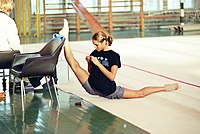
Photo from wikipedia
Soft tissue moves relative to the underlying bone during locomotion. Research has shown that soft tissue motion has an effect on aspects of the dynamics of running; however, little is… Click to show full abstract
Soft tissue moves relative to the underlying bone during locomotion. Research has shown that soft tissue motion has an effect on aspects of the dynamics of running; however, little is known about the effects of soft tissue motion on the joint kinetics. In the present study, for a single subject, soft tissue motion was modeled using wobbling components in an inverse dynamics analysis to access the effects of the soft tissue on joint kinetics at the knee and hip. The added wobbling components had little effect on the knee joint kinetics, but large effects on the hip joint kinetics. In particular, the hip joint power and net negative and net positive mechanical work at the hip was greatly underestimated when calculated with the model without wobbling components compared with that of the model with wobbling components. For example, for low-frequency wobbling conditions, the magnitude of the peak hip joint moments were 50% greater when computed accounting the wobbling masses compared with a rigid body model, while for high-frequency wobbling conditions, the peaks were within 15%. The present study suggests that soft tissue motion should not be ignored during inverse dynamics analyses of running.
Journal Title: Journal of applied biomechanics
Year Published: 2022
Link to full text (if available)
Share on Social Media: Sign Up to like & get
recommendations!